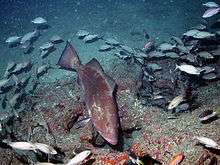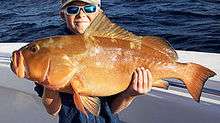Red grouper
| Red grouper | |
|---|---|
 | |
| Scientific classification | |
| Kingdom: | Animalia |
| Phylum: | Chordata |
| Class: | Actinopterygii |
| Order: | Perciformes |
| Family: | Epinephelidae |
| Genus: | Epinephelus |
| Species: | E. morio |
| Binomial name | |
| Epinephelus morio (Valenciennes, 1828) | |
The red grouper (Epinephelus morio) is a species of fish in the Family Epinephelidae. The red grouper's typical range is coastal areas in the western Atlantic, stretching from southern Brazil to North Carolina in the US and including the Gulf of Mexico.[1][2][3][4] This demersal, largely sedentary species has an extended (~40 day) pelagic larval stage before it settles in shallow coastal hardbottom habitat as juveniles. They remain in inshore waters for 4–5 years before migrating to offshore hardbottom habitat—particularly on the edge of the continental self—as adults. Spawning occurs offshore between January and June, peaking in May. While primarily eating benthic invertebrates, the red grouper is an opportunistic feeder in the reef community. The diet commonly includes xanthid and portunid crabs, juvenile spiny lobster, and snapping shrimp, with the occasional fish. The red grouper is of moderate size, about 125 cm and weighs 23 kg or more. Body coloration is typically reddish-brown color often with many white spots. When aggravated (they are highly territorial) or involved in spawning activities, these fish can very rapidly change coloration patterns, with the head or other parts of the body turning completely white, and the white spots appearing more intense.
Life history characteristics

Red grouper, like a number of other grouper species, are long-lived, slow to mature, protogynous hermaphrodites, beginning life as females, with some later transforming into males. Females transform into males between the ages of 7 and 12.[5] These characteristics make them highly vulnerable to overfishing.[6] Refer to the sidebar on the right to see its current conservation status on the IUCN red List.
Habitat engineers of the sea
Red grouper actively excavate pits in the seafloor. This activity increases the architectural complexity of the habitat, which attracts other organisms and increases local biodiversity.[7] They start digging in the sediment from the time they settle out of the plankton and continue throughout their lifetime. They use their caudal fin and their mouths to remove debris and sediment from rocks, creating exposed surfaces on which sessile organisms actively settle (e.g., sponges, soft corals, algae). The exposure of structure also attracts a myriad of other species, including mobile invertebrates and a remarkable diversity of other fishes, from gobies and butterflyfish to grunts and snapper. The lionfish Pterois volitans started invading red grouper habitat by 2008, from Florida Bay to the Florida Keys and offshore to Pulley Ridge, a mesophotic coral reef on the West Florida Shelf west of the Dry Tortugas. Known for being extremely capable predators on small reef fish, scientists are very interested in determining the extent to which their invasion changes the functional dynamics of associated communities.
Parasites
As other fish, red groupers harbour a number of parasites,[8] including, on its gills, the monogeneans Pseudorhabdosynochus justinella and Pseudorhabdosynochus yucatanensis.
| Wikimedia Commons has media related to Red grouper. |

References
- ↑ "Biology of the Red Grouper (Epinephelus morio" Valenciennes) from the eastern Gulf of Mexico." (PDF). Retrieved 2014-08-20.
- ↑ "Red grouper (Epinephelus morio Valenciennes)-FISHBASE.". Retrieved 2014-08-24.
- ↑ "Red grouper (Epinephelus morio Valenciennes)-SMITHSONIAN MARINE STATION.". Retrieved 2010-10-06.
- ↑ Including Anguilla, Antigua and Barbuda, Aruba, the Bahamas, Barbados, Belize, Bermuda, Brazil, Cayman Islands, Colombia, Costa Rica, Cuba, Dominica, the Dominican Republic, French Guiana, Grenada, Guadeloupe, Guatemala, Guyana, Haiti, Honduras, Jamaica, Martinique, Mexico, Montserrat, Netherlands Antilles, Nicaragua, Panama, Puerto Rico, Saint Kitts and Nevis, Saint Lucia, Saint Vincent and the Grenadines, Suriname, Trinidad and Tobago, Turks and Caicos Islands, Venezuela, the British Virgin Islands, and the U.S. Virgin Islands
- ↑ "Reproductive styles of shallow-water grouper, consequences of fishing spawning aggregations". Retrieved 2014-08-24.
- ↑ "American Fisheries Society Position Statement: Long-lived reef fishes: the grouper-snapper complex.". Retrieved 2014-08-24.
- ↑ "Benthic Habitat Modification by Red Grouper" (PDF). Retrieved 2014-08-20.
- ↑ Moravec F, Vidal-Martínez VM, Vargas-Vázquez J, Vivas-Rodríguez C, González-Solís D, Mendoza-Franco E, Simá-Alvarez R, Güemez-Ricalde J (1997). "Helminth parasites of Epinephelus morio (Pisces: Serranidae) of the Yucatan Peninsula, southeastern Mexico" (PDF). Folia Parasitologica. 44 (4): 255–66. PMID 9437838.

Sources
- Garcia-Moliner & G., Eklund, A-M. 2004. Epinephelus morio. 2006 IUCN Red List of Threatened Species. Downloaded on 4 August 2007.
